Noel Tobin
Planning Covent Garden
By Noel Tobin
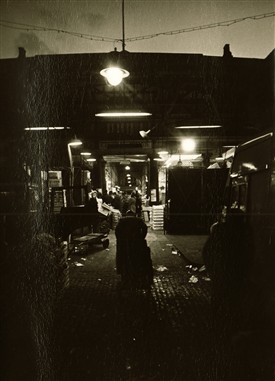
The Old Market before it moved to Nine Elms
Penny Saunders
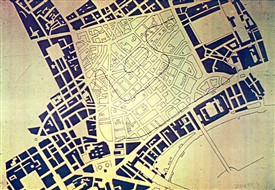
Map of Covent Garden
Covent Garden Community Association
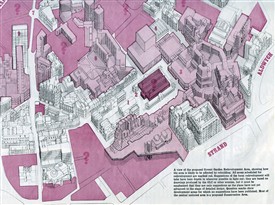
The original plan for the Covent Garden area
Jim Monahan
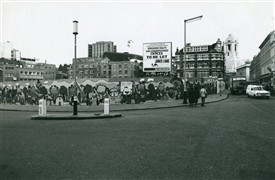
The site where Odhams Printing Press once stood
Covent Garden Community Association
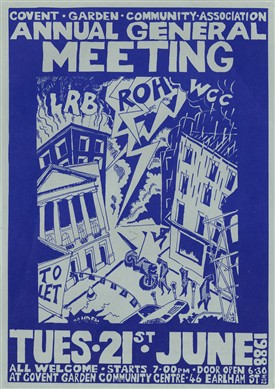
1988 AGM poster for the Covent Garden Community Association
Covent Garden Community Association
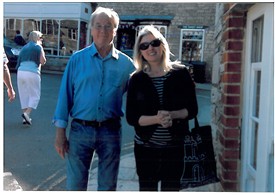
Noel Tobin
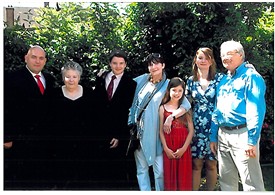
Noel Tobin
We came to Covent Garden in 1968 after living for several years in Soho and a brief period at Finsbury Park. My wife Geraldine and I had been married at St Patrick’s Church Soho Square in 1966 and had our first child Natasha not long after; our second child Fiona, came along in 1969.
We were both working in the West End Theatre industry at the time. I worked at the New London Theatre Drury Lane when it was built and when it closed for a period, I moved onto the Royal Opera House, where I worked on stage lighting for 33 years.
We lived in the community and we were part of the community, so when the re-development plan for Covent Garden was announced by the GLC we were all aghast at its implications. They wanted to get rid of as much of the old area as they could after the market moved to Nine Elms, and to turn the area into a sort of Canary Wharf with hotels, conference centres and other large buildings. Had it gone a head it would have looked very much like the City of London.
In 1971, the Covent Garden Community Association (CGCA) began and we all joined up. Because of the huge protests against the plan the Secretary of State for the environment, Geoffrey Rippon, was forced to call it in and the New Area Action Plan was announced. This plan would involve everyone who lived, worked or owned a property in the Covent Garden area. These local representatives were engulfed into a new body, the Covent Garden Forum, which came into being in the early 1970s after 250 buildings in Covent Garden had been listed. The Forum was made up of everyone connected with the area: 9 residents, 9 services (including theatres and churches), 9 businesses and 3 owners of property who would be elected every 2 years. I stood for election and was successful in 1974. The Forum was set up and run like a Council with a postal ballot under the auspices of the GLC. There was the GLC Covent Garden Team, led by Geoff Holland and based in King Street, who transformed the Market Building and other buildings they owned. They attended all of the main Forum meetings and we worked with them on the New Area Action plan. I stood for re-election each time and usually came second with the highest number of votes
I chaired the housing sub-committee part of the Forum. The Rev Austin Williams, the famous vicar of St Martins-in-the-Fields, was its Chairman for almost the entire period of the Forum. Simon Pembroke, a lecturer at UCL, was its Secretary. When Simon stood down I became Secretary and worked directly with Austin. When he retired I became the Chairman of the Forum. Our offices were at Bedford Chambers, an old building in the Piazza, which is no longer there having been replaced by a new building currently occupied by Apple. It has been said that the Forum was just a business orientated organisation, but the Forum was made up of many different people with the future of Covent Garden as their primacy.
When we first came to Covent Garden the old Market was still here and in its final two years. After it closed and moved piecemeal developments in the area began. A huge new office development was started in Long Acre, just opposite where we lived. The Odhams Printing Press had also substantial premises in Long Acre which burnt down. This was at a time when there were a number of mystery fires in the area, for example the Civil Service Stores in the Strand burnt down twice! In the interim on the Odhams site we had a community garden and the famous Japanese Garden which was enjoyed by all of us. Then came the Chicago Bank and the land for the present 104 flats given to the Council. People in housing need in the area and other parts of Westminster were supposed to be given priority and overall it worked like that in the main.
As we worked on the New Plan for Covent Garden 250 building were listed and saved, this meant that the area could not be demolished despite the best efforts of some businesses and entrepreneurs. The Forum always considered the many different factions involved, and always consulted with the CGCA when writing the plan and they in turn came up with their versions and their changes, so when the plan was written we had agreement and involvement. As well as the new area taking shape we had not only the new shops but a section of the old market in the form of the Jubilee Market, opposite the Piazza.
The late John Toomey and Sam Driscoll were great figures in the area as was and still is Jim Monahan who kept the fight for the area and the inspiration going. Great writers like John Betjeman lent their names to ensure Covent Garden would never be destroyed. It was a tough fight but we won although there are some who would say we lost what Covent Garden was all about. Looking at the area today I would say that overall I do not think we lost. It was an area where alongside the market, the arts and crafts also excelled with a number of small shops and big buildings, the Royal Opera House, the Drury Lane Theatre and a number of smaller theatres survived. The shopping changed as it has in almost every area of the country and we still have the Jubilee Market thanks to Ray Green. Like Halles in Paris when their great market was moved it is visited by millions every year.
In 1988, I closed down the Forum once the New Plan was written and put out to the press and public. It was a great success. The Minister for Environment, Lord Young, came to the area invited by us. I met him and took him through the Piazza and to the old Bedford Chambers where our office was and he met the members of the Forum. Also present was the best MP the area ever had, Peter Brooke. The Forum archive is now held at the Museum of London.
The buildings of the area continued under the Covent Garden Area Trust, a new body put together from the business community to look after the buildings of the area after the Forum, which I joined. However the Covent Garden Area Trust cannot be compared to the wider organisation of the Forum or the CGCA.
Meanwhile the CGCA came onto difficult times because of the cuts in funding from the Local Authorities and the abolition of the GLC, but thankfully it still exists today under the great Jo Weir, representing all those of us who live in the area. The CGCA has its office in the community centre (Seven Dials Club) in Earlham Street.